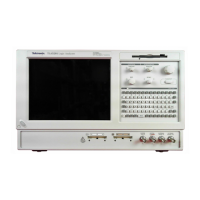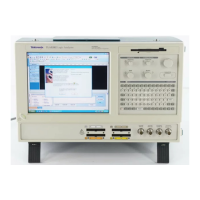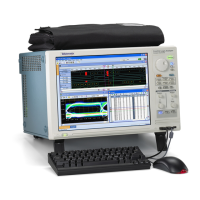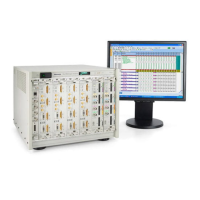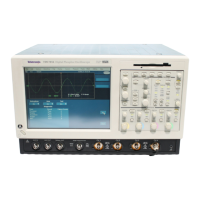Theory of operation
The control fea
tures o f the new TekFlex interface include two analog tip offset
voltage signals, a pair of digital communication signals for acc essing the p robe tip
S-parameter memory, and a probe tip temperature monitor signal.
The probe tip S-parameter memory contains characterization data for use with
DSP correction filters that are unique to the probe tip. The S-parameter memory
includes a unique data header used in automatically identifying the probe tip
type and serial number. The A and B signal outputs from the probe tip are
connected by high frequency spring contacts in the TekFlex connector to a pair of
delay-mat
ched coaxial cables that carry the input signals through the main cable
and into the comp box. These signals terminate to a pair of 50 Ω termination
resistors at the probe amplifier in the comp box. The termination resistors have
an adjustable termination voltage connection for optimal loading of the probe
tip output signal s. The TekFlex interface messenger wires are routed as a small
gauge ribbon cable, along with the delay-matched coaxial cables, inside a shielded
main cab
le assembly.
The P7700 Series probe amplifier has several cascaded amplifier stages that
condit
ion the probe tip differential signal for precision measurement fidelity. The
complex input stage of the probe amplifier selects the desired TriMode input mode.
This i
nput stage of the probe amplifier includes connections for injecting a pair
of adjustable probe offset voltages for precision c ontrol of the probe output zero
voltage, which is a measure of the output signal with zero volts at both probe
tip inputs.
The next stage in the probe amplifier is the step gain stage. The step gain stage
provides several switchable, coarse gain steps, that extend the sensitivity range of
the probe measurement down to the millivolt level with good noise performance.
The step gain stage is automatically switched to its optimum setting by the
os
cilloscope as the oscilloscope vertical channel sensitivity is adjusted by the user.
The final stage of the probe amplifier is the variable gain stage. The variable
g
ain stage is used for fine tune adjustment of the gain of the probe and probe tip
to its calibrated value. The calibrated gain setting is determined from calibration
constants characterized during manufacturing testing of the probe and probe
tip and includes compensation for probe temperature variation. Although the
signal that passes through the probe amplifier is processed as a differential signal
through the internal amplifier stages, it is routed to the osc illoscope’s TekConnect
interface as a single-ended output.
P7700 Series TriMode Probes Technical Reference 7

